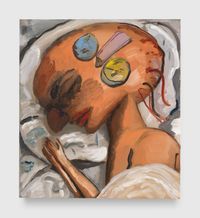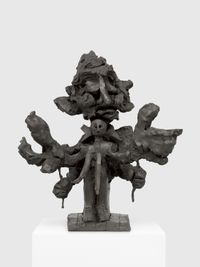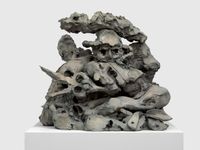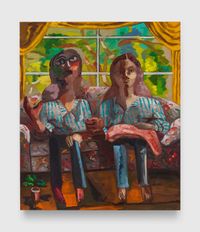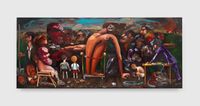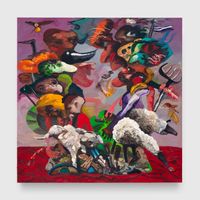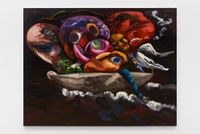Dana Schutz is an American painter known for her imaginative and unbridled canvases that depict hypothetical events and impossible scenarios, characterised by expressionistic brushwork and an effervescent use of colour.
Read MoreDana Schutz's paintings combine abstraction and figuration in order to construct complex accounts of emotional and psychological states, where fragmented bodies and extreme behaviours offer a humorous and discomforting vision of reality.
Born in 1976 in Livonia, Michigan, Dana Schutz studied at the Cleveland Art Institute and received her masters at Columbia University in 2002. There, she was praised by the artist Cecily Brown for her 'bulletproof constructions' and clarity of expression, exemplified in her groundbreaking MFA show Frank from Observation (2002).
For Frank from Observation (2002), Schutz imagined herself as the last painter on earth, and Frank as the last subject. She pictured her subject in comic and vulnerable positions in order to ask questions about the role of the artist, the subject, and the viewer. Throughout her work, Schutz poses absurd and elaborate 'what if?' scenarios to explore a range of pictorial and existential quandaries.
Dana Schutz's paintings are also profound investigations into art history, peopled with auto-cannibalising figures, totemic gods, and poisoned presidents. Her 'Self Eater' series (2004) depicts macabre figures gorging on their own bodies, reconfiguring themselves thought visceral brushstrokes into images of intense terror and distress.
In Schutz's 'God' series (2013), the artist attempted to grapple with representations of divinity, compressing and stacking her subject within the canvas—a process she likened to building a house. In these powerfully envisioned artworks, Schutz recalls the influence of artists such as Max Beckmann, Gustave Courbet, Jean Dubuffet, Philip Guston, Pablo Picasso, and Masaccio.
During the 2017 Whitney Biennial, Schutz's Open Casket (2016) became the centre of controversy. The painting depicted the corpse of Emmett Till: a 14-year-old who who was lynched by two white men in Mississippi and whose death spurred the Civil Rights Movement. In the following years, Schutz began experimenting with sculpture.
Working in a similar fashion to her paintings for her sculptures, Schutz first prepares drawings, then she builds her forms out of clay before casting them in bronze. Their pock-marked surfaces appear weathered by external forces or the erosion of internal turmoil. Humanoid figures grow second heads or attempt to pacify monsters that also ensnare them. In these tragic and absurd moments, Schutz confronts the turbulent and unpredictable condition of our times.
Eating Atom Bombs, Transformer Station, Cleveland (2018); Dana Schutz, Institute of Contemporary Art, Boston (2017); Dana Schutz, Musée d'art Contemporain de Montréal (2015); Dana Schutz, The Hepworth Wakefield, England (2013); Works on Paper, Museum of Contemporary Art, Denver (2012); Dana Schutz, Museo d'arte Moderna e Contemporanea di Trento e Rovereto, Italy (2010).
Amy Weng | Ocula | 2020
